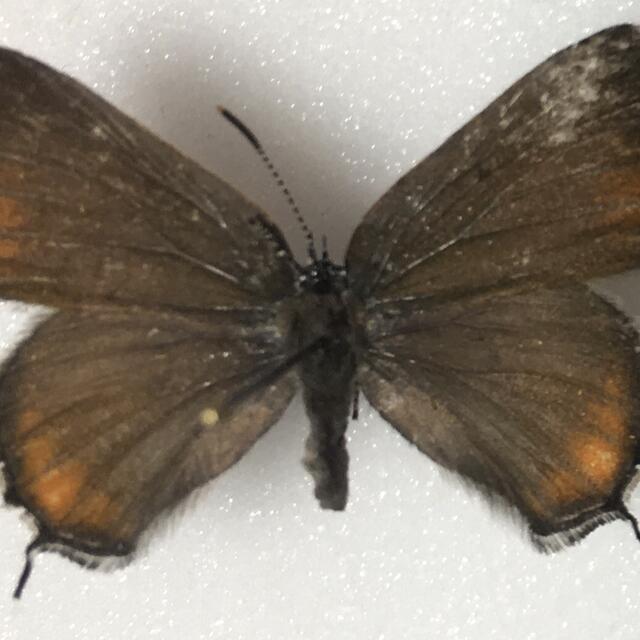California Hairstreak
Satyrium californica (W.H. Edwards, 1862)
Family: Lycaenidae
Subfamily: Theclinae
Identification: Each hindwing has 1 long and 1 short tail. Upperside brown with orange spot on hindwing near tails. Outer edge of forewing usually has row of orange spots. Underside brown-gray with orange submarginal crescents and a postmedian band of black spots.
Wing Span: 1 - 1 1/4 inches (2.5 - 3.2 cm).
Life History: Males search for females by perching on top of trees (occasionally patrolling). Females lay eggs, glued together in groups of 2-4, in bark crevices. Eggs hibernate until the following spring. Caterpillars eat leaves.
Flight: One flight from May-August.
Caterpillar Hosts: Amelanchier alnifolia, Prunus virginiana; Cercocarpus, Ceanothus, Quercus, and Salix species.
Adult Food: Nectar from flowers of wild buckwheat, milkweed, sulphur flower, and others.
Habitat: Chaparral, brushland, forest edges, open woodland.
Range: British Columbia south to southern California and east to Colorado.
Conservation: Valley oak-associated population in California\'s central valley is threatened by loss of habitat.
NCGR: G4 - Apparently secure globally, though it might be quite rare in parts of its range, especially at the periphery.
Management Needs: Conserve remaining stands of Valley oak in California Central Valley.
Comments: NULL
Alternate Scientific Names:
Satyrium californicum
BAMONA Shop
Please donate!
We depend on donations to keep Butterflies and Moths of North America freely available. We want to express our gratitude to all who showed their support by making a contribution this year. You can donate to support this project at any time.
Advertise with us!
Do you have a product or service that you think would interest BAMONA users? If you would like to advertise on this website, contact us by email, or use the contact form and select the "Advertising" category.
Verified Sightings
Displaying 1 - 24 of 406 verified sightings

Observation date: Jun 20, 2025
Submitted by: ezeemonee
Region: Santa Barbara County, California, United States
Verified by: Ken Davenport
Verified date: Aug 30, 2025

Observation date: Jun 13, 2025
Submitted by: TomPeterson
Region: Santa Clara County, California, United States
Verified by: Ken Davenport
Verified date: Jun 22, 2025

Observation date: May 30, 2025
Submitted by: ezeemonee
Region: San Diego County, California, United States
Verified by: Ken Davenport
Verified date: Jun 02, 2025

Observation date: May 23, 2025
Submitted by: ezeemonee
Region: Los Angeles County, California, United States
Verified by: Ken Davenport
Verified date: May 27, 2025

Observation date: May 18, 2025
Submitted by: camflies
Region: Santa Barbara County, California, United States
Verified by: Ken Davenport
Verified date: May 19, 2025

Observation date: Jun 26, 1987
Submitted by: papilio1
Region: Washoe County, Nevada, United States
Verified by: Ken Davenport
Verified date: Feb 27, 2025

Observation date: May 24, 2024
Submitted by: icosahedron
Region: Sonoma County, California, United States
Verified by: Ken Davenport
Verified date: Jul 03, 2024

Observation date: Jun 09, 2024
Submitted by: ezeemonee
Region: Ventura County, California, United States
Verified by: Ken Davenport
Verified date: Jun 12, 2024

Observation date: Jun 06, 2024
Submitted by: Seth Mueller
Region: Riverside County, California, United States
Verified by: Ken Davenport
Verified date: Jun 06, 2024

Observation date: Jul 12, 2023
Submitted by: Paul C. Agidius
Region: Latah County, Idaho, United States
Verified by: stevekohler
Verified date: Sep 12, 2023

Observation date: Jul 15, 2019
Submitted by: tjunderwood
Region: Mariposa County, California, United States
Verified by: Ken Davenport
Verified date: Aug 22, 2023

Observation date: Aug 10, 2023
Submitted by: Robert Gorman
Region: Mono County, California, United States
Verified by: Ken Davenport
Verified date: Aug 17, 2023

Observation date: Aug 12, 2023
Submitted by: Dobber31
Region: Mono County, California, United States
Verified by: Ken Davenport
Verified date: Aug 16, 2023

Observation date: Aug 12, 2023
Submitted by: Dobber31
Region: Mono County, California, United States
Verified by: Ken Davenport
Verified date: Aug 16, 2023

Observation date: Aug 12, 2023
Submitted by: Dobber31
Region: Mono County, California, United States
Verified by: Ken Davenport
Verified date: Aug 16, 2023

Observation date: Jun 16, 2020
Submitted by: CFreeman
Region: Nevada County, California, United States
Verified by: Ken Davenport
Verified date: Jun 15, 2023

Observation date: Jun 01, 2023
Submitted by: hiker96
Region: Klickitat County, Washington, United States
Verified by: davidwdroppers
Verified date: Jun 04, 2023

Observation date: May 31, 2023
Submitted by: Dobber31
Region: Santa Clara County, California, United States
Verified by: Ken Davenport
Verified date: Jun 01, 2023

Observation date: Jul 25, 2022
Submitted by: gasigr
Region: Lake County, Oregon, United States
Verified by: Ken Davenport
Verified date: Mar 06, 2023

Observation date: Jul 25, 2022
Submitted by: gasigr
Region: Lake County, Oregon, United States
Verified by: Ken Davenport
Verified date: Mar 06, 2023

Observation date: Aug 22, 2022
Submitted by: MAKI
Region: Lincoln County, Nevada, United States
Verified by: Ken Davenport
Verified date: Oct 13, 2022

Observation date: May 01, 2022
Submitted by: ezeemonee
Region: Ventura County, California, United States
Verified by: Ken Davenport
Verified date: May 02, 2022

Observation date: Jun 16, 2018
Submitted by: Robert Gorman
Region: San Bernardino County, California, United States
Verified by: Ken Davenport
Verified date: Dec 08, 2021

Observation date: Aug 02, 2017
Submitted by: Mark Salvato
Region: Alpine County, California, United States
Verified by: Ken Davenport
Verified date: Nov 16, 2021
- 1 of 17
- next ›




